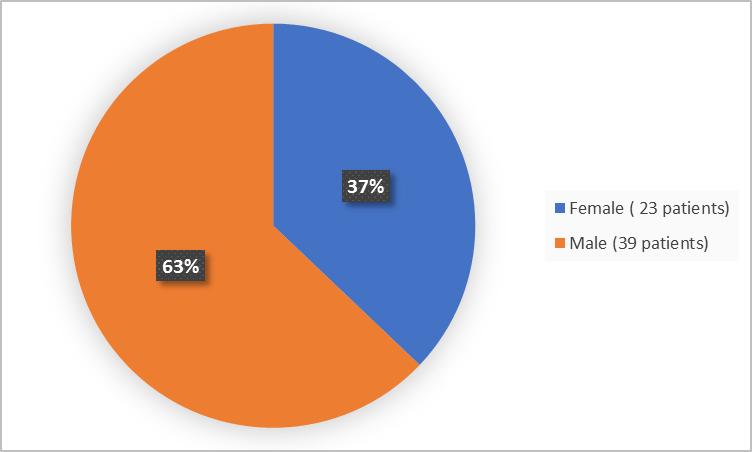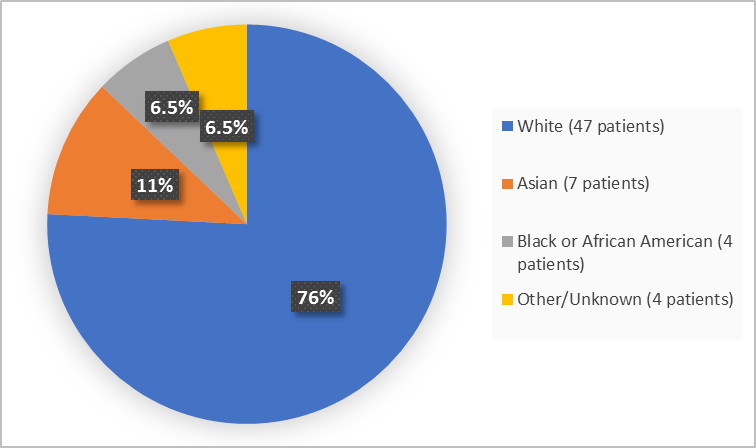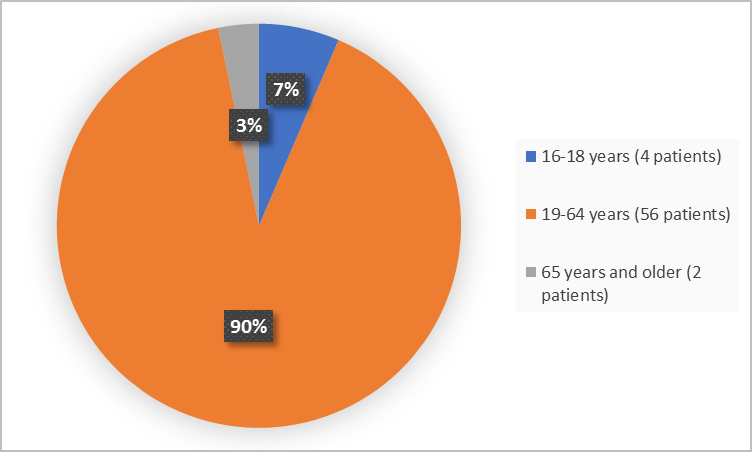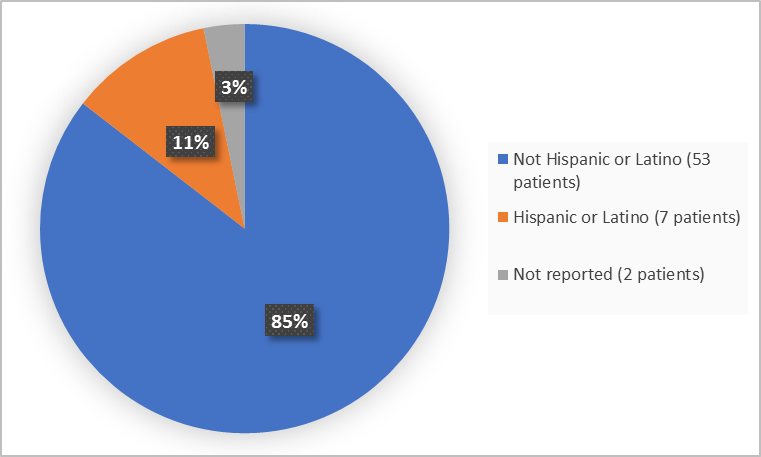Drug Trials Snapshots: TAZVERIK
HOW TO USE THIS SNAPSHOT
The information provided in Snapshots highlights who participated in the clinical trials that supported the FDA approval of this drug, and whether there were differences among sex, race, and age groups. The “MORE INFO” bar shows more detailed, technical content for each section. The Snapshot is intended as one tool for consumers to use when discussing the risks and benefits of the drugs.
LIMITATIONS OF THIS SNAPSHOT:
Do not rely on Snapshots to make decisions regarding medical care. Always speak to your health provider about the risks and benefits of a drug. Refer to TAZVERIK Prescribing Information for complete information.
TAZVERIK (tazemetostat)
(taz vayr′ ik)
Epizyme
Approval date: January 23, 2020
DRUG TRIALS SNAPSHOT SUMMARY:
What is the drug for?
TAZVERIK is a drug used to treat a type of cancer called advanced epithelioid sarcoma. It is to be used in patients 16 years and older when cancer has spread and cannot be completely removed by surgery.
Epithelioid sarcoma is a rare, slow growing type of cancer that begins in the soft tissues of the body (most commonly under the skin of an extremity).
How is this drug used?
TAZVERIK is a tablet. Four tablets (a total of 800 mg) are taken twice a day.
What are the benefits of this drug?
Out of 62 patients who received TAZVERIK, 9 patients (15%) achieved partial or complete shrinkage of the cancer. For 6 of these patients (67%) the shrinkage lasted six months or longer.
TAZVERIK was approved under FDA’s accelerated approval program, which provides earlier patient access to a promising new drug while the company continues to conduct clinical trials to confirm and further assess the clinical benefit.
What are the benefits of this drug (results of trials used to assess efficacy)?
The table below summarizes efficacy results for the clinical trial based on overall response rate (ORR) according to Response Evaluation Criteria in Solid Tumors (RECIST) v1.1 as assessed by blinded independent central review (BICR) and duration of response (DOR).
Table 1. Efficacy Results Efficacy Results for the Epithelioid Sarcoma Cohort 5 of Trial 1
| Efficacy Endpoints | TAZVERIK N=62 |
|---|---|
| Overall Response Rate (95% CI)* | 15% (7%, 26%) |
| Complete Response | 1.6% |
| Partial Response | 13% |
| Duration of Response | |
| % with duration ≥ 6 months | 67% |
| Range in months | 3.7, 24.5+ |
CI: Confidence Interval
*Time to response ranged from 2.4 to 18.4 months.
TAZVERIK Prescribing Information
Were there any differences in how well the drug worked in clinical trials among sex, race and age?
- Sex: TAZVERIK worked similarly in males and females.
- Race: The majority of patients in the clinical trial were White. Differences in response to TAZVERIK among races could not be determined.
- Age: The majority of patients in the clinical trial were adults between 18-64 years of age. Differences in response to TAZVERIK among different age groups including those above 65 years of age could not be determined.
Were there any differences in how well the drug worked in clinical trials among sex, race, and age groups?
The table below summarizes efficacy results by subgroups. Because of the small sample size, these results should be interpreted with caution.
Table 2. Subgroup Analysis of ORR
| Demographic characteristic | Subgroup | # Responses | N | ORR (95% CI) |
|---|---|---|---|---|
| Sex | ||||
| Female | 5 | 23 | 22% (7, 44) | |
| Male | 4 | 39 | 10% (3, 24) | |
| Age | ||||
| <65 years | 8 | 60 | 13% (6, 25) | |
| ≥65 years | 1 | 2 | 50% (1, 99) | |
| Region | ||||
| United States | 3 | 40 | 8% (2, 20) | |
| Outside United States | 6 | 22 | 27% (11, 50) | |
CI=confidence interval
FDA Review
What are the possible side effects?
TAZVERIK may cause serious side effects including development of other cancers and harm to an unborn baby.
The most common side effects of TAZVERIK are pain, tiredness, nausea, decreased appetite, vomiting and constipation.
What are the possible side effects (results of trials used to assess safety)?
The table below summarizes adverse reactions that occurred in the clinical trial in ≥10% of patients.
Table 3. Adverse Reactions (≥10%) in Patients Receiving TAZVERIK
| Adverse Reaction | TAZVERIK N=62 |
||
|---|---|---|---|
| All Grades (%) | Grade 3-4 (%) | ||
| General | |||
| Paina | 52 | 7 | |
| Fatigueb | 47 | 1.6 | |
| Gastrointestinal | |||
| Nausea | 36 | 0 | |
| Vomiting | 24 | 0 | |
| Constipation | 21 | 0 | |
| Diarrhea | 16 | 0 | |
| Abdominal painc | 13 | 1.6 | |
| Metabolism and nutrition | |||
| Decreased appetite | 26 | 4.8 | |
| Respiratory, thoracic and mediastinal | |||
| Cough | 18 | 0 | |
| Dyspnead | 16 | 4.8 | |
| Vascular | |||
| Hemorrhagee | 18 | 4.8 | |
| Nervous system | |||
| Headache | 18 | 0 | |
| Blood and lymphatic system | |||
| Anemia | 16 | 13 | |
| Investigations | |||
| Weight decreased | 16 | 7 | |
aIncludes tumor pain, pain in extremity, non-cardiac chest pain, flank pain, back pain, arthralgia, bone pain, cancer pain, musculoskeletal pain, myalgia, neck pain
bIncludes fatigue and asthenia
cIncludes abdominal pain, gastrointestinal pain, abdominal pain lower
dincludes dyspnea and dyspnea exertional
eIncludes wound hemorrhage, rectal hemorrhage, pulmonary hemorrhage, hemorrhage intracranial, cerebral hemorrhage, hemoptysis
TAZVERIK Prescribing Information
Were there any differences in side effects among sex, race and age?
- Sex: The occurrence of side effects was similar in males and females.
- Race: The majority patients in the clinical trial were White. Differences in side effects among races could not be determined.
- Age: The majority of patients in the clinical trial were adults between 18-64 years of age. Differences in side effects among different age groups including those above 65 years of age could not be determined.
Were there any differences in side effects of the clinical trials among sex, race, and age groups?
Tables below summarize selected adverse reactions by sex and race subgroups. Because of the small sample size, these results should be interpreted with caution.
Table 4. Subgroup Analysis of Adverse Reactions by Sex
| Adverse Reaction | Female N=23 n (%) |
Male N=39 n (%) |
|---|---|---|
| Paina | 11 (48) | 21 (54) |
| Fatigueb | 8 (35) | 20 (51) |
| Nausea | 10 (44) | 12 (31) |
aGroup hemorrhage includes PT terms pulmonary hemorrhage, wound hemorrhage, rectal hemorrhage, hemorrhage intracranial, cerebral hemorrhage, and hemoptysis
bGroup fatigue includes PT terms fatigue, and asthenia
Adapted from FDA Review
Table 5. Subgroup Analysis of Adverse Reactions by Race
| Adverse Reaction | White N=47 n (%) |
All Other N=15 n (%) |
|---|---|---|
| Paina | 26 (55) | 6 (40) |
| Fatigueb | 26 (55) | 2 (13.) |
| Nausea | 19 (40) | 3 (20) |
aGroup hemorrhage includes PT terms pulmonary hemorrhage, wound hemorrhage, rectal hemorrhage, hemorrhage intracranial, cerebral hemorrhage, and hemoptysis
bGroup fatigue includes PT terms fatigue, and asthenia
Adapted from FDA Review
WHO WAS IN THE CLINICAL TRIALS?
Who participated in the clinical trials?
The FDA approved TAZVERIK based primarily on the evidence from one clinical trial (NCT02601950) of 62 patients with advanced epithelial sarcoma. The trial was conducted at 22 sites in France, United Kingdom, Taiwan, Italy, Canada, Belgium, and the United States.
The figure below summarizes how many men and women were in the clinical trial.
Figure 1. Demographics by Sex
Adapted from FDA Review
Figure 2 summarizes the percentage of patients by race in the clinical trials.
Figure 2. Demographics by Race
Adapted from FDA Review
Figure 3 summarizes the percentage of patients by age in the clinical trial.
Figure 3. Demographics by Age
Figure 4. Demographics by Ethnicity
Adapted from FDA Review
Who participated in the trials?
The table below summarizes demographics of patients in the clinical trial.
Table 6. Baseline Demographics of Patients in the Clinical Trial
| TAZVERIK N=62< n (%) |
|
|---|---|
| Sex | |
| Female | 23 (37) |
| Male | 39 (63) |
| Race | |
| Black or African American | 4 (6.5)< |
| Asian | 7 (11) |
| White | 47 (76) |
| Other/Unknown | 4 (6.5)< |
| Age (years) | |
| Mean years (SD) | 37 (15) |
| Min, Max | 16, 79 |
| Age Group (years) | |
| 16-18 | 4 (6) |
| 19-64 | 56 (91) |
| ≥65 | 2 (3) |
| Ethnicity | |
| Not Hispanic or Latino | 53 (85) |
| Hispanic or Latino | 7 (11) |
| Not reported | 2 (3) |
| Country | |
| France | 4 (6) |
| Canada | 2 (3) |
| United States | 40 (65) |
| Taiwan | 3 (5) |
| Italy | 6 (10) |
| Great Britain | 2 (3) |
| Belgium | 5 (8) |
Adapted from FDA Review
How were the trials designed?
The benefit and side effects of TAZVERIK were evaluated in one clinical trial of 62 patients with advanced epithelial sarcoma. All patients received TAZVERIK twice daily (total of 800 mg) until disease progression or unacceptable toxicity.
The benefit of TAZVERIK was evaluated by measuring the percentage of patients who experienced partial or complete shrinkage of their tumors (overall response rate) and how long that shrinkage lasted (duration of response).
How were the trials designed?
The safety and efficacy of TAZVERIK were established in an open-label, single-arm cohort (Cohort 5) of a multi-center trial in patients with histologically confirmed, metastatic or locally advanced epithelioid sarcoma. Patients received TAZVERIK 800 mg orally twice daily until disease progression or unacceptable toxicity.
The efficacy outcome measures were confirmed ORR according to RECIST v1.1 as assessed by BICR and DOR.
GLOSSARY
CLINICAL TRIAL: Voluntary research studies conducted in people and designed to answer specific questions about the safety or effectiveness of drugs, vaccines, other therapies, or new ways of using existing treatments.
COMPARATOR: A previously available treatment or placebo used in clinical trials that is compared to the actual drug being tested.
EFFICACY: How well the drug achieves the desired response when it is taken as described in a controlled clinical setting, such as during a clinical trial.
PLACEBO: An inactive substance or “sugar pill” that looks the same as, and is given the same way as, an active drug or treatment being tested. The effects of the active drug or treatment are compared to the effects of the placebo.
SUBGROUP: A subset of the population studied in a clinical trial. Demographic subsets include sex, race, and age groups.
PRESCRIBING INFORMATION




